I would venture to say that Vladimír Suchý and Delicious Games have cracked the code for SPIEL Essen. Same as with Woodcraft the previous year, they had managed to create a high level of anticipation for their new game Evacuation before the fair even started. But many other publishers managed to do that part as well. Where Suchý and Delicious Games stand out is that they also managed to bring sufficient supplies so that the vast majority of people who wanted to get a copy also managed to get one. From what I’ve heard, they brought north of 2000 copies to Essen this year and I assume they sold most of them, judging by the fast shrinking stacks of boxes I saw and the persistent queue in front of their booth.
The interesting question is of course: what remains after the convention rush? Woodcraft was – from what I can tell – mostly well regarded but dropped off people’s radar pretty quickly. While Underwater Cities remains a classic and there is still a loyal fan base for Pragna Caput Regni, things have gotten quiet around Woodcraft. It had a super tight economy (which already put some people off) but also felt like a puzzle: a bit frustrating in the beginning and once you had it cracked, there was less incentive to bring it back to the table. So will Evacuation turn out to be a Woodcraft or an Underwater Cities? Or in other words, is it just good or really good?
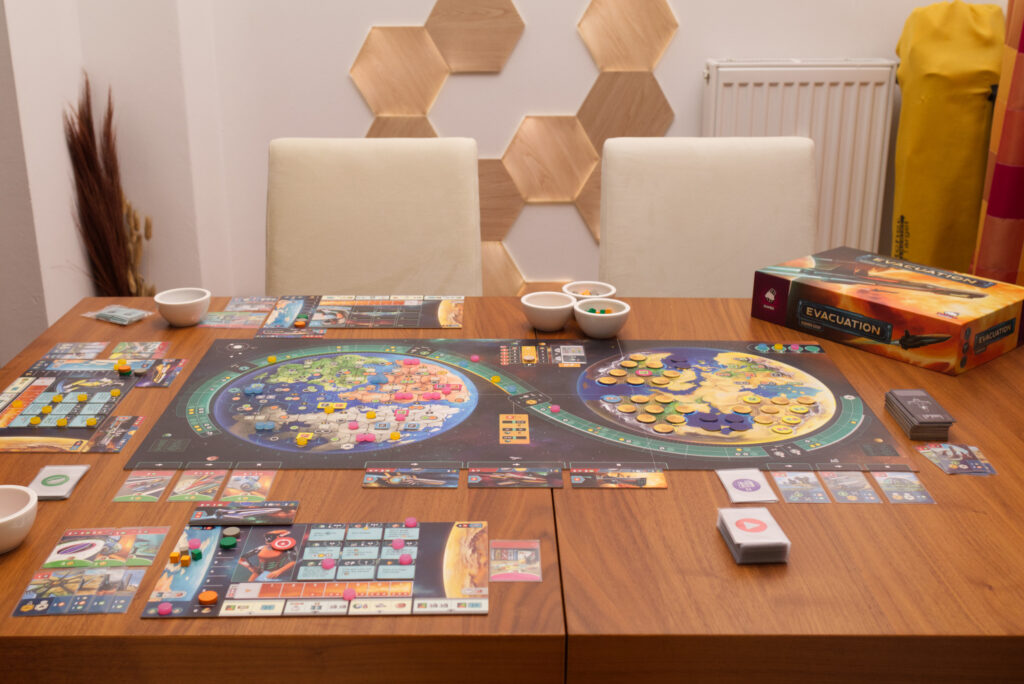
Setup
Evacuation comes in the compact box format anybody who bought Underwater Cities will be familiar with. Inside it is a beautifully illustrated main board that shows two planets: the “old world” and the “new world”. Over the course of just four rounds, players need to tear down their pre-existing old world economy and rebuild it on the new world before it’s too late and the old world dies. The old world economy of each player is represented by round cardboard tokens showing population and factories in the colours of the resources they produce. Energy (orange) is used to provide you with actions and fuel the giant space ships that evacuate your old world belongings and ship them over to the new world. Metal (grey) is needed to construct those spaceships, but also for settling your refugees on the new world or build stadiums for entertainment and infrastructure (more on those later). Food (green) is needed in small doses for various things but primarily is there to feed the population on both worlds.
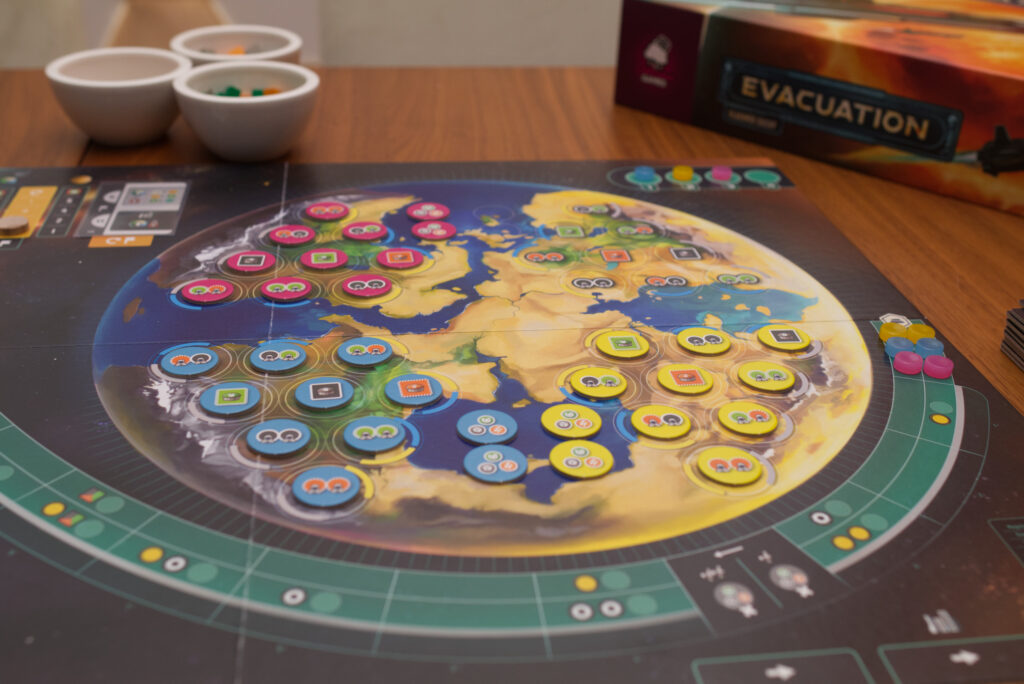
At the very start of the game, all of the old world population and factories together provide a quite sizeable resource income for each player, but things go inevitably downhill from there. Just leaving everything in place on the old world isn’t an option as players will be measured at game’s end by the size of their new world production alone and everything not evacuated from the old world will cost them negative points. But every piece moved off the old world means a reduction in income, hampering what a player can do in the following rounds.
Besides their old world economy tiles, each player also receives a personal player board, one of four sets of unlockable technology tiles, and places two discs on the progress track that spans from the old to the new world. The latter has multiple functions but roughly manages in what areas of the new world a player can settle (more progress results in better regions) and to what degree they can still utilise their energy from the old world or have to rely on new world production.
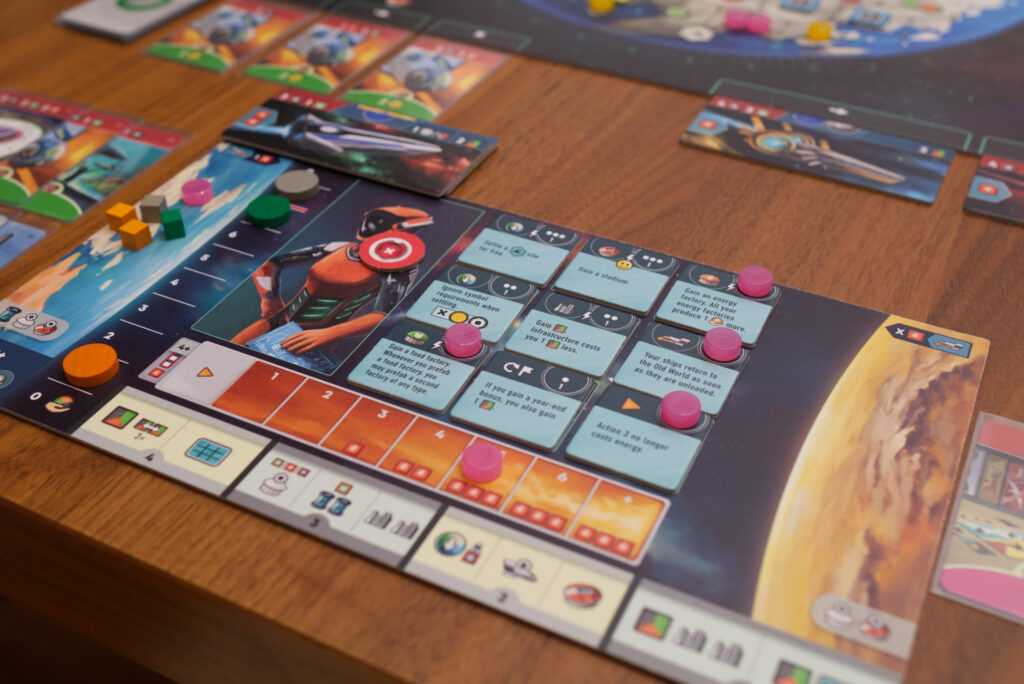
Towards the top of the board is the round tracker that shows the demands of each player’s population. Initially, only the old world’s population needs to be fed. But over time, the demands for food and entertainment (provided by stadiums) in the new world grows, putting pressure on the players to re-establish their economy quickly. Note that these are always the same fixed numbers and independent of how many people a player might already have transported to the new world. It’s more a yardstick one has to jump over, otherwise there’ll be hell to pay.
Finally, at the bottom of the board, there are three markets for purchasing stadiums, ships and infrastructure which all work in the same way: if one is picked up, the remaining entries slide to the right to fill the gap and a new one is revealed. I’ve left out a few other elements, but suffice to say while there is a variety of tokens and cards to be put out, with the proper use of ziplock bags setup is rather swiftly done.
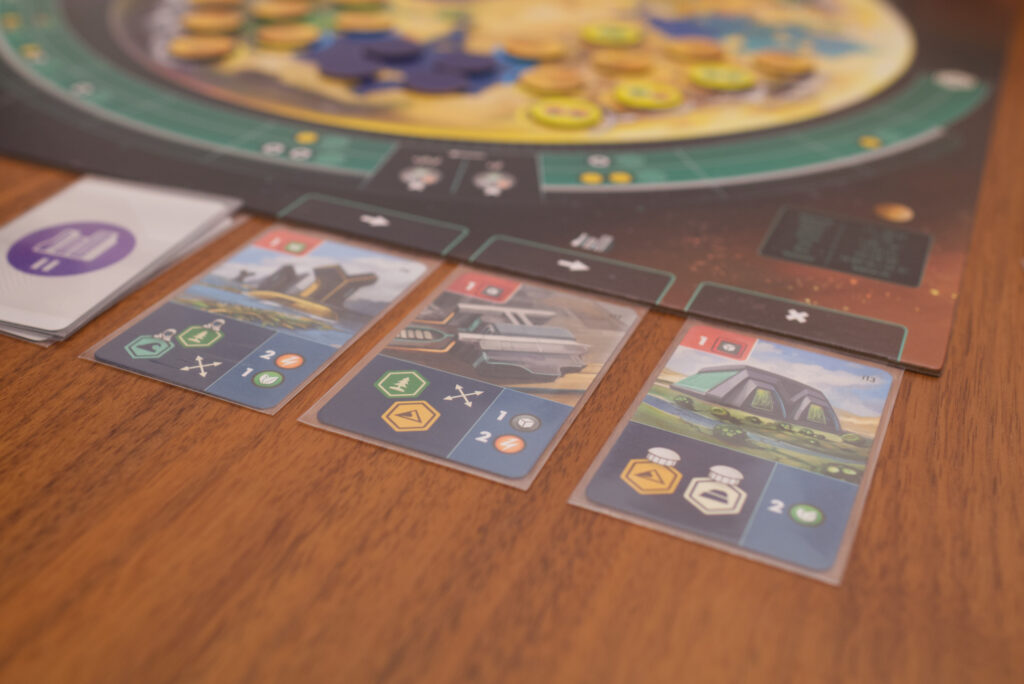
The Turn
Each of the four rounds starts with an income phase where the old and new world produce resources – depending on what population and factories a player has on them. The fundamental rule of the game is: if something is produced, it stays on that world and has to be used on that world. The only way to move things between worlds is with ships. For that reason, the player board has two separate storage areas, one for each world. On the old world, the remaining cardboard discs show what production each player still has there. For the new world, every piece of population, factory, or infrastructure settled on it increases the three coloured production discs on the new world production track on each player’s board.
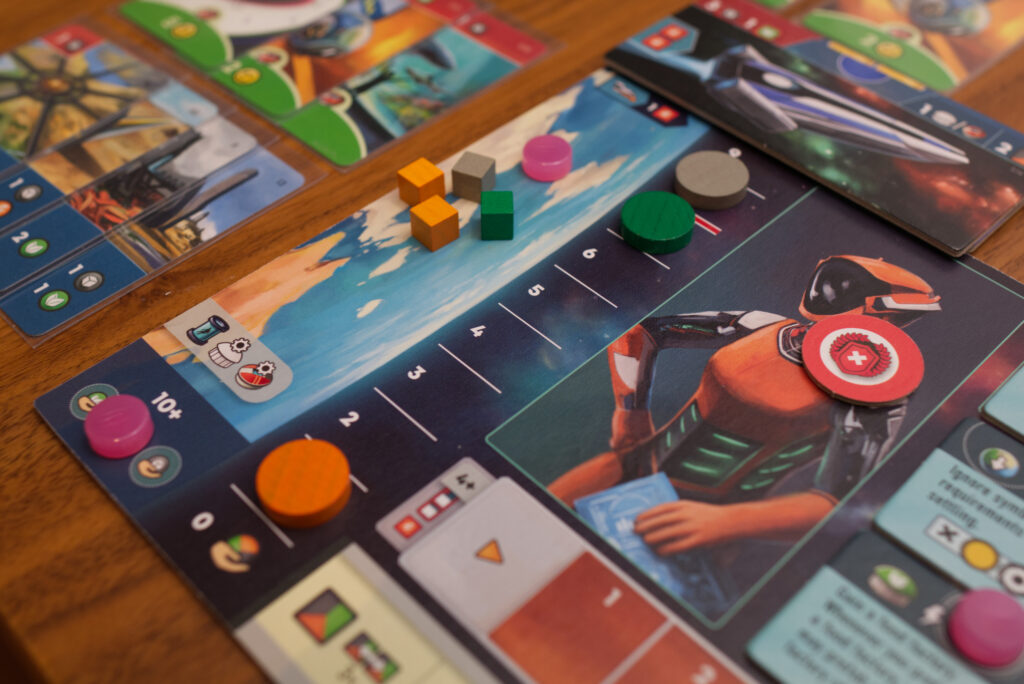
Next, population needs to be fed, which for the first turn is limited to the old world. With increasing number of rounds, the needs of the old world will go down and those of the new world will go up. Starting from turn three, the new world population also will demand an increasing number of stadiums, represented by a deck of cards. For the round check, it doesn’t matter how big or small the stadium is. However, purchasing more expansive stadiums provides more happy people (symbolised by a smiley) which are used to get ahead in the turn order. Since all requirements are fixed amounts that stay the same from game to game and there are only three types of resources, doing this first phase of a turn is super quick and leads directly into the action phase.
How exactly the action phase is played depends on whether or not players use the standard game or the advanced action variant. Don’t let the names fool you: Evacuation is one of those few games where the standard mode is already a fully fledged heavy game and switching to the advanced mode just adds another layer on top of it. The following will describe the standard mode and in a later section highlight the differences.
Either way, the active player has to decide what action they want to do and how much progress (called “power level”) that action should produce. All actions are shown at the bottom of the player board and are grouped into sections 1 to 4. To perform an action, the player takes an action card, flips it to its generic back side, and places it into the respective slot of the action they want to perform. While the first two actions in a round are free, starting from the third one each will cost an increasing amount of energy. There is no limit on how many actions a player can take in one turn, just a natural limit of how many a player can afford to buy.
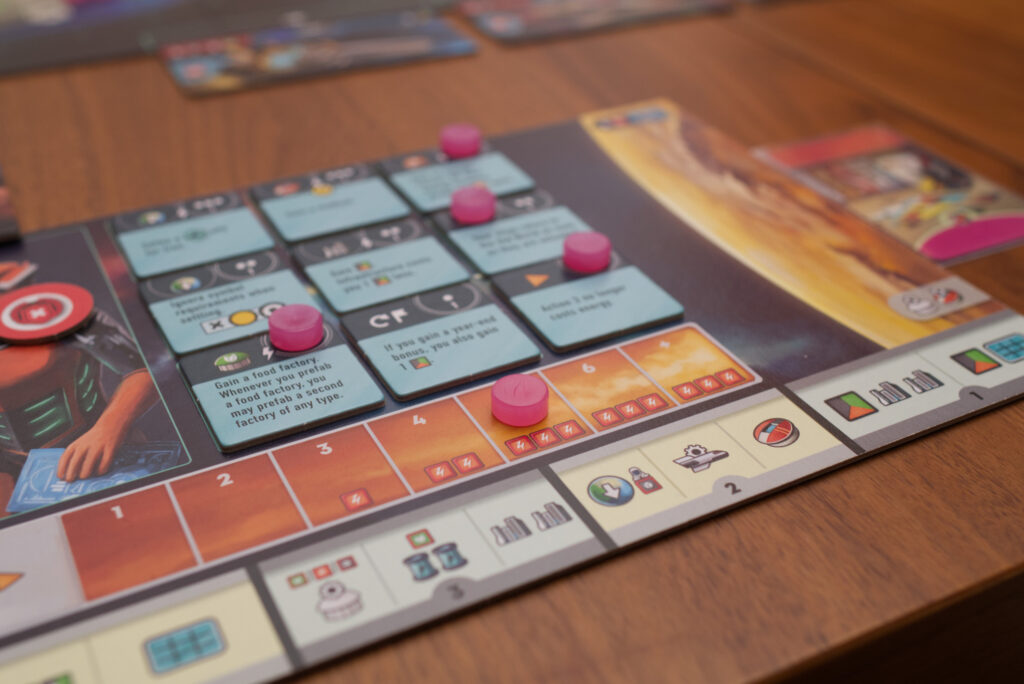
Here are the available actions in a nutshell: draw or play infrastructure cards (which provide resource production but require a certain amount/pattern of new world settlements to exist), researching technology (which unlocks highly useful, asymmetric capabilities), buying a ship (needed to transport populations, buildings, and goods to the new world), buying a stadium, settling a hex-space in the new world, cloning (creating population to be settled in the new world out of thin air), pre-fabbing (turning a resource into a factory), and exchanging resources for those of another type. Some of these actions exist as two options: one with a higher progress value but no additional benefit and another with a lower progress value but it comes with a free resource.
One by one, players chose their actions, pay their energy cost, and then perform them – which typically only takes a couple of seconds. The action phase continues until all players have passed. Once it is completed, players switch over to the transportation phase where they can pay energy to activate the ships they own. Each ship has a number of characteristics such as from which type of terrain they can evacuate people/factories and how many, to what extend they can ship resources to the new world, and if they can transport stadiums or factories as well. Everything shipped over gets put on the new world side of the player board where it has no effect yet and in a later round has to be settled on to the new world with the populate action.
Note that during one transportation phase, ships only fly one way and then drop off their cargo. To get a ship back to the old world takes another turn as well as energy cubes from the new world to fire up the engines. Sometimes this can be lucrative, sometimes it’s better to just buy another ship on the old world. But since the whole game only lasts four rounds, there isn’t as much movement as one might initially think. For at least half the ships, it’s rather a one way trip towards the new world.
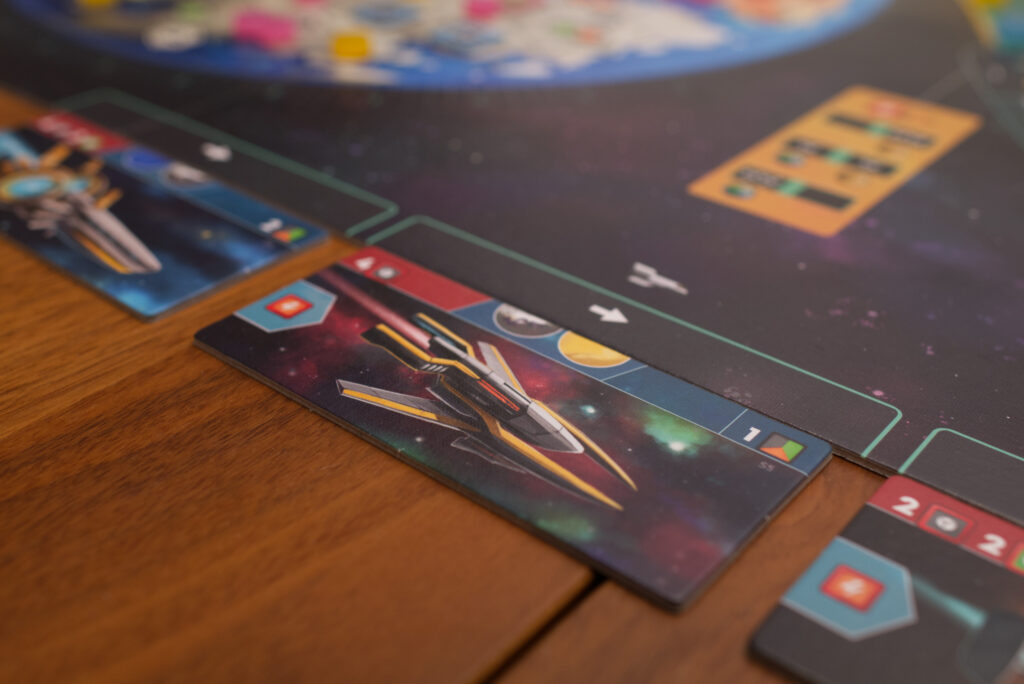
Turn order changes based on the number of happy faces each player has (either from stadiums or unlocked technologies) before players move their two satellites on the progress track. For that, each card contributes a movement equal to the slot it is placed in (e.g. a card in the “3” group of actions results in three steps). Players can split that amount among their two satellites as they advance them on the progress track. Both having a lot as well as having very little progress can be a valid strategy, and of course everything in between. Pushing for high progress unlocks more lucrative hexes on the new world for that player but cuts them off from the old world energy production more quickly (reducing the number of actions they will be able to pay for). Also moving a satellite over a certain point will cause part of their old world production capabilities to disappear. On the other hand staying behind forces a player to ONLY use energy from the old world to pay for actions but preserves those old world production capabilities a little bit longer.
If that wasn’t big enough of a decision already, there are bonuses such as a free tech upgrade or resource printed on the progress track which are awarded if a player lands on those squares. Other spaces provide symbols that are necessary to build in some prime locations. Since players can’t forfeit progress points, planning one’s own actions to end up with a specific progress value can be highly important. And to top things off, each round a card is revealed that shows two bonuses that are awarded if a player’s progress matches exactly a certain number (e.g. get one free ship if you have a progress of 6 or two free resources if you hit 13). So choosing which action to take and from what slot is an essential part of planning your turn.
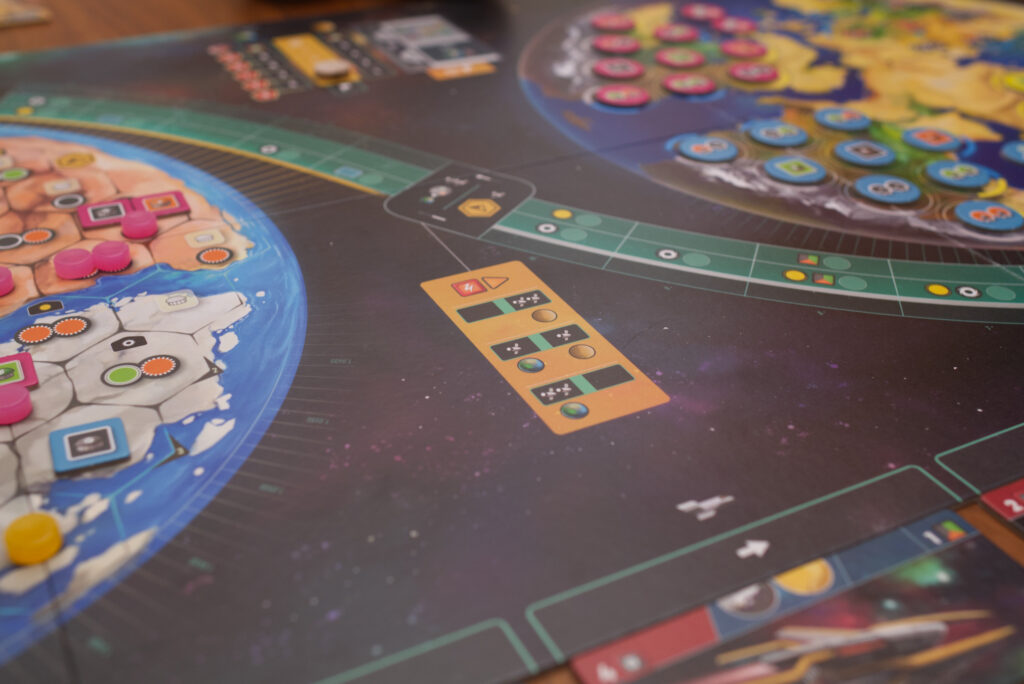
Finally, to close out the round, the rightmost card of each of the three markets is discarded and each player resets their counter for the number of actions they have taken. The round marker is moved to the next round and another phase of income & checks begins. Looking at the overall round structure, the vast amount of time is spent in the action phase and all the other phases can either happen in parallel or are really snappy.
Technology & Infrastructure
There are a number of elements that are added on top of the core income-buy-transport-resettle-progress loop. An unusual aspect of Evacuation’s design is how it uses its technology tiles. Each player gets the 9 tiles of a numbered, asymmetric set. They are arranged at random into three columns and players have to research lower tiles before being able to unlock higher tiles in the same column. This creates an interestingly fresh way of having to rethink your strategy each game despite the sets themselves staying the same. Should you go for the tech tile that has your ships fly back to the old world in the same turn or rather double the production of your energy factories? It all depends on which column is the most attractive combination of traits in this session.
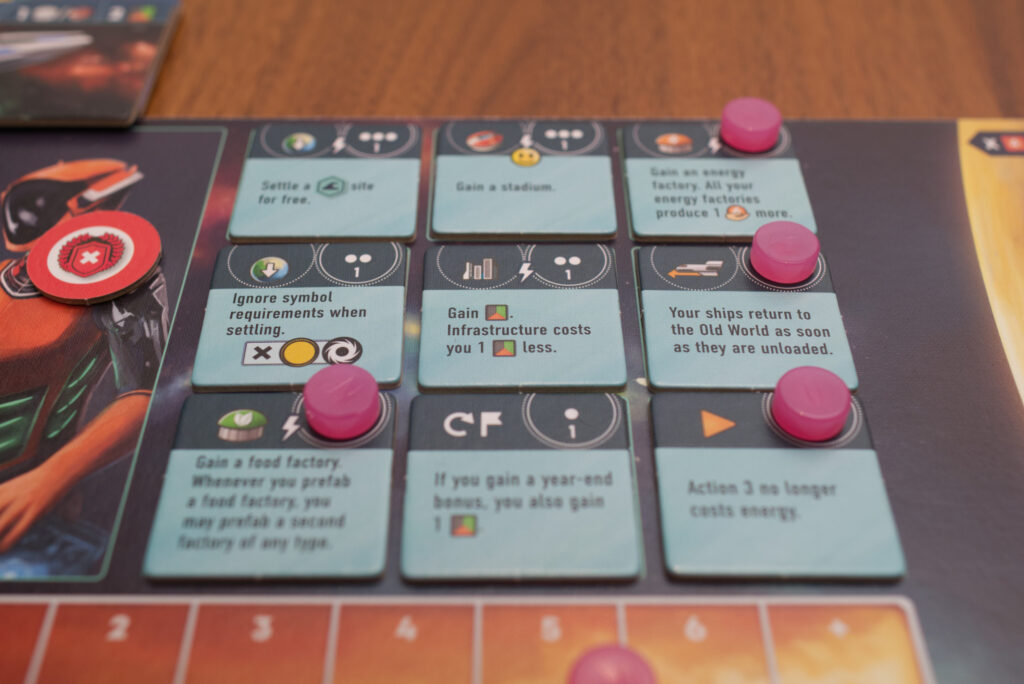
The other thing worth noting are the infrastructure cards. These are probably the easiest way to ramp up production in the new world quickly. While they are cheap to get and deploy (they just cost a single metal or food to play), they come with building restrictions such as you needing two hexes with population on a particular continent and one in another – or – all on the same diagonal line. At first, these felt a bit overpowered until we realised how easy it is to block someone from building the more useful ones of them if people pay attention. Plus competition to get the more powerful ones increased once we had seen how useful they are.
What might feel a bit strange is the limited quantity in choice here. There are exactly 4 sets of tech tiles, it’s just their position in the columns that changes. For infrastructure, there are just 18 cards and it’s not unlikely that players will go through all of them in a single session. For the progress bonuses, they’re just two potential bonus combinations for the last round. One the one hand, more cards would have made for some nice variety, on the other hand knowing that specific infrastructure cards always will show up allows for better strategising.
Strategic Implications
Evacuation is one of those games where you might struggle a bit learning the new terms and internalise the rules, but once you’re there, it is super easy to play. All of the actions on their own are rather straight forward. So to give you a better feel of what it’s like to play on your fifth or tenth play, let’s talk about some of the implications of those simple actions.
To start with, the number of actions you’ll be able to take is typically around 5 per round, which will set you back 6 energy already. Every ship you want to fly off to the new world will set you back 1-2 energy, every time you place the fourth card into the same action spot will cost you an additional energy, and so on. Starting the game with a production of 7 energy doesn’t make that sound too bad, but it can also been seen this way: even in the beginning of the games when things are easy and one can rely on a full economy on the old world, having a single ship that requires two energy to fly may cost the player a whole action. Doing even more than these 5 actions will cost some serious effort since every further action will set the player back 3 additional energy.
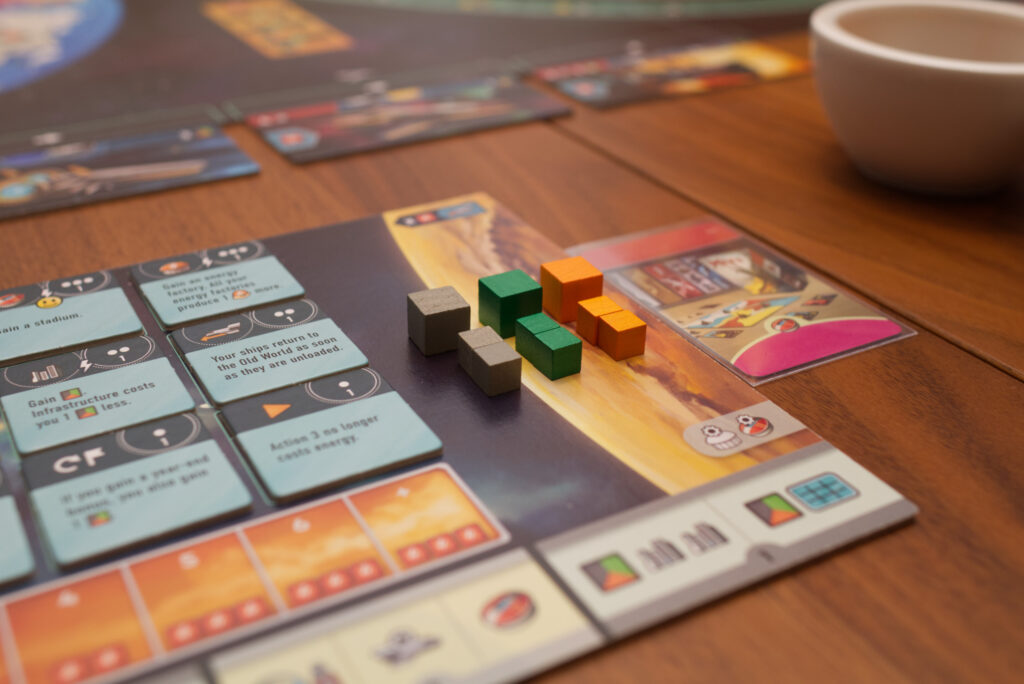
A similar story for metal: You’ll need metal to buy ships and stadiums, but also one per population you settle on the new world (which can consume a lot of metal pretty quickly) as well as to pay for infrastructure. Food is tight due to the demands of feeding both the new and old world, but is also required for some stadiums, infrastructure and cloning. Long story short: every single cube counts.
And things get tighter and tighter from here on. With every piece of population or factory you evacuate from the old world, your production is reduced and it takes time to rebuild a substitute on the new world. If you tear down something during the transport phase in turn one, you’ll lose its effects for the income phase of turn two and can only build it in time for turn three’s income phase … that is if you even have both the actions and resources to actually settle the shipped over stuff onto the planets surface. Similarly with progress: as soon as your satellites move over the first checkpoint on the progression track, you lose 1 cube production of each resources per satellite. Only after BOTH satellites have passed the second checkpoint do you get to reclaim one of those productions on the new world.
As a result, there is a natural dip in production. Soon, 7 production of each resource will seem like a faint memory of better times which you will struggle to get back to until round 4. The faster you do the evacuation, the more you’re hurting yourself. The slower you do it, the more you set up yourself for trouble in later rounds as you suddenly need to figure out how to clear out the old world in a rush. It’s like having to climb up a cliff and the only way to do it is to chop off one arm so you have something to grab on to and pull yourself up.
What also becomes painfully obvious quickly is how interconnected everything is. If you chose to primarily select actions from slot 1 and 2 (often attractive due to the free resources and tech unlocking), you won’t progress quickly and lock yourself out of populating the most lucrative areas in the new world. If you progress too quickly, you’ll hurt your economy and get sooner into a situation where you no longer can use energy from the old world to pay for your actions. If you don’t build stadiums, you will be last in turn order and others will have claimed all the good spots on the progress track, robbing you of free tech upgrade steps. If you pick up a certain infrastructure card too early, you’re signalling what population pattern you need and they can easily get in your way. If you try to pick it up too late, another player might have snatched it up before you. And so on …
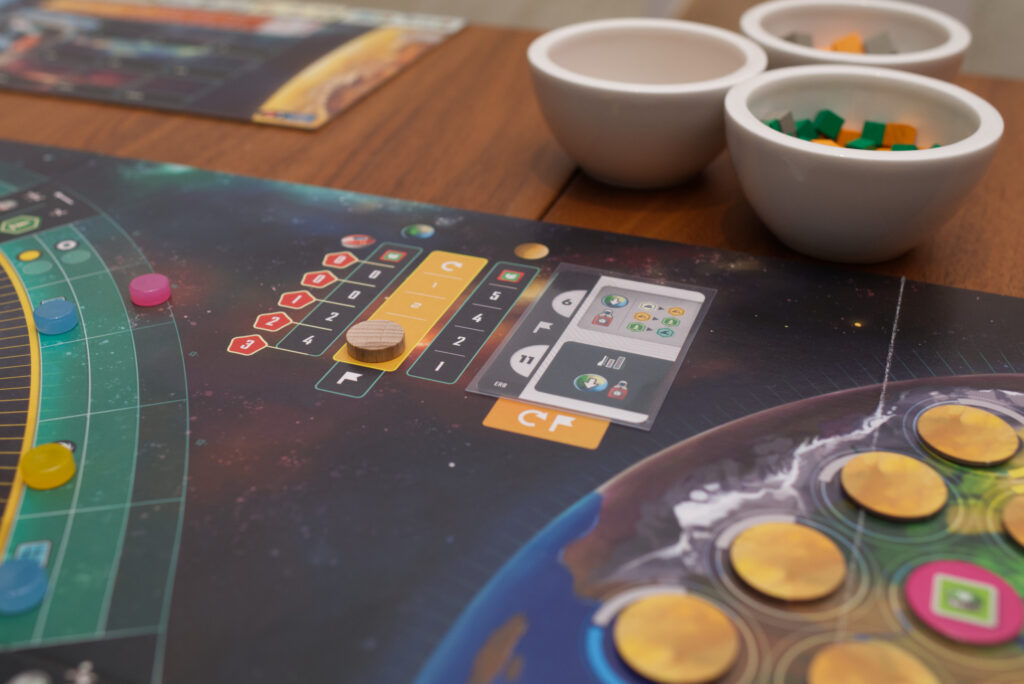
Finally, the importance of those occasional free bonus resources cannot be overstressed. Not only will having that one extra cube often be the difference between your plan working or not working at all, but also it’s up to the player on which world to put it! Using actions that come with a free resource is the only way how to get resources to the new world outside the transport or income phase. Quite often you will need to perform such an action simply because you need one new world energy to have your ship return home or one metal to actually settle that population you brought over and have it add to your production.
End of Game
There are two major modes in which the game can be played. The rules suggest to play initially in race mode which ends the game as soon as one player has reached a production of 8 in each resource and put 3 stadiums on the new world. Each remaining player in turn order gets one more action and that’s it. This can happen quite abruptly and the first time we got there it was a case of “wait, that’s it?”. As the name implies, it’s a race. Players are then ranked based only on their lowest resource production (e.g. 6 food vs 9 metal and 8 energy = 6) with penalties for any time the food and stadium requirements were not met. Also every single piece of old world economy a player didn’t evacuate is another step down for their lowest production marker.
In points mode, the game always is played until the end of the fourth round and scoring is changed a bit but fundamentally stays similar: the higher your new world production, the better, everything not evacuated or demands not fulfilled are bad. Points mode can also be spiced up by drafting goals (such as gain VP for each point of metal production capabilities), public shared goals, certain diagonals becoming more valuable and so on. There is also a number of smaller modules players can add or not depending on what they fancy. I liked using the goals quite a lot because it forces players to go off the beaten path and try new approaches.
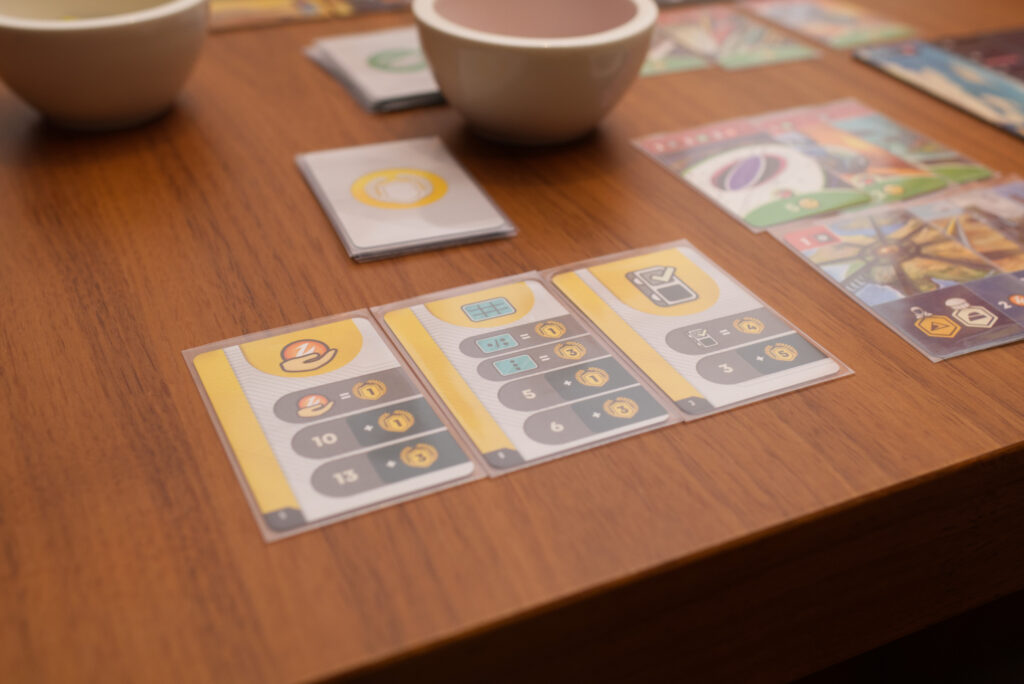
Advanced Action Cards
Things are mixed up slightly when using the advanced actions. In addition to the actions printed on the player boards, each player gets 4 cards that show new combinations of actions and elements already familiar to players from the ones printed on the player board. Players have the option to play one of their cards for the action (and progress value) printed on them or flip them and place them into an action slot as done in the normal mode, after which they redraw back up to four cards. Additionally, the action 1 group that contains both of the highly attractive actions that provide a free resource can now only be used once per round.
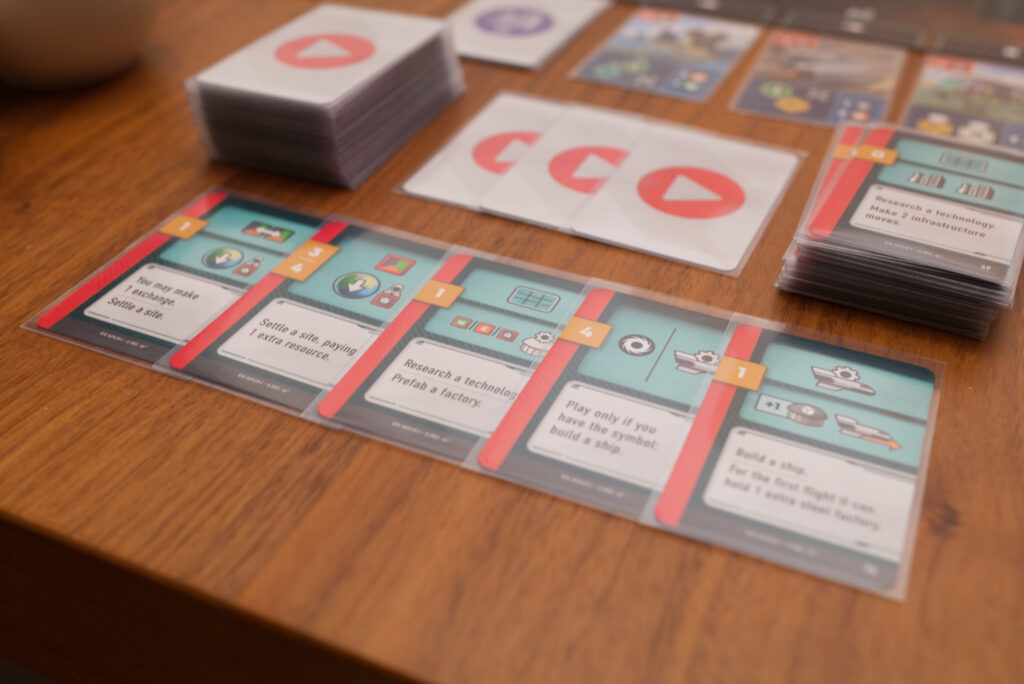
There’s a couple of things to note here. First, Evacuation doesn’t feel any less of a game by playing without the advanced actions. The cards simply add another choice that often allows players to double down on certain strategies but on the other hand can overwhelm new players with choice. Whether you play with them or without them won’t change anything with regards to the arc of the game or the strategies that can be employed. Second, the hand size of 4 feels quite limiting. Sometimes one has collected very tempting advanced actions but needs to do a standard action, forcing you to choose one of those cards to flip and slot into the standard action slots, their unique effect unused.
I had the feeling that using the advanced actions helped me achieve higher scores. Whether that was a fluke or it will be consistently so will have to be seen. I’m happy to play either way and wouldn’t describe one version better than the other, just slightly different. Adding the drafted goals had a far larger impact on the game in my experience so far.
Solo Mode
Evacuation has a typical Suchy-style solo mode that feels similar to the one used in Messina 1347. Fundamentally, the human player plays on their own but there is a small automa deck that takes away stadiums, infrastructure, and ships but mostly populates hexes on the new world. Basically, it just gets in the way but doesn’t compete. The aim of the solo mode is to beat at least 60 VP while 80 VP is considered mastery. For that, points mode with drafted goals is used.
It took me 5-6 solo plays plus two 2p plays to get there and using the advanced action card mode might have helped. But it took some serious learning and experimenting to get a hang of how to achieve such a score. Knowing Suchy, I’m a bit surprised I got there so fast (I still haven’t beaten Underwater Cities’ solo mode when using the expansion content) but maybe I misplayed some minor detail. I definitely took 2-3 backsies where I received a free resource of my choice and on the very next action realised I needed a food instead of an energy or so on, but nothing major.
The solo mode works fine and since Evacuation is initially a rather multiplayer solitaire experience anyway, there isn’t much lacking compared to the multiplayer experience. With more advanced players though, I see the direct blocking on the new world and offensively-buying of ships or stadiums to play a bigger role. Those parts of course cannot be captured by such a simple solo mode.
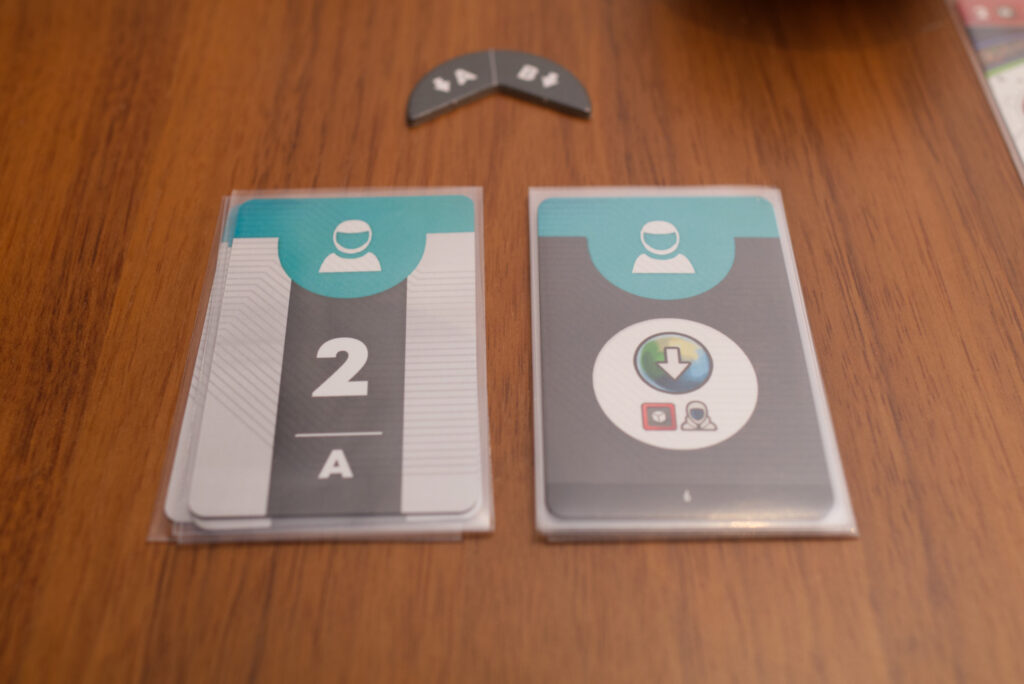
Conclusion
What makes Evacuation stand out from a flood of other new releases is the surprising number of interesting aspects in a single game. Starting off with the theme, which I enjoy quite a lot. Evacuation feels like a thematically better version of the fundamental idea behind Messina 1347, taking something away to then later rebuild it. Starting players off with large production capabilities instead of the usual blank slate is a really interesting twist to the Euro game genre. It’s like being asked to shoot yourself in the foot and you seriously contemplating the pros and cons of picking the left foot or the right one. There is no way to play Evacuation and not end up with a worse production in the second round than the first. Well, technically speaking you could decide to not evacuate anything, cut your progress short, and instead start cloning or build factories on the new world. But that would cost so many resources and actions that you’d be worse off in the long run. Or perhaps not.
So far there have been a number of different approaches I’ve seen and I was surprised to learn how many viable options there are. For example, a friend recently started to use the trade-resources action multiple times in succession to trade metal into energy and thus fuel the next execution of the same action again. Basically he was burning metal for progress as each trade action contributes 4 points of progress. By the time he was done using up his resources, he had an obscene amount of progress. And still, despite us all taking different paths, all three players hit that red 8-production line that triggers the game’s end on the exact same turn of the action phase!
The next thing that becomes apparent immediately is how tight the economy is. Having a single extra resource cube can have big cascading consequences. This is somewhat alleviated by having the option to use the low-progress actions that come with a free resource of your choice. But that only shifts the problem: quite often, having picked a free cube of one resource instead of another can be enough to cause some serious problems. Personally, I found the majority of the individual action decisions easy to make as they were all part of a bigger plan I had for that round. But sometimes it would take 10 minutes to decide what free resource to pick. We started saying “you go, I figure it out before it’s my next turn”. It can truly be agonising to choose whether you need that one energy or instead a food … or a metal instead? Or back to the energy again?
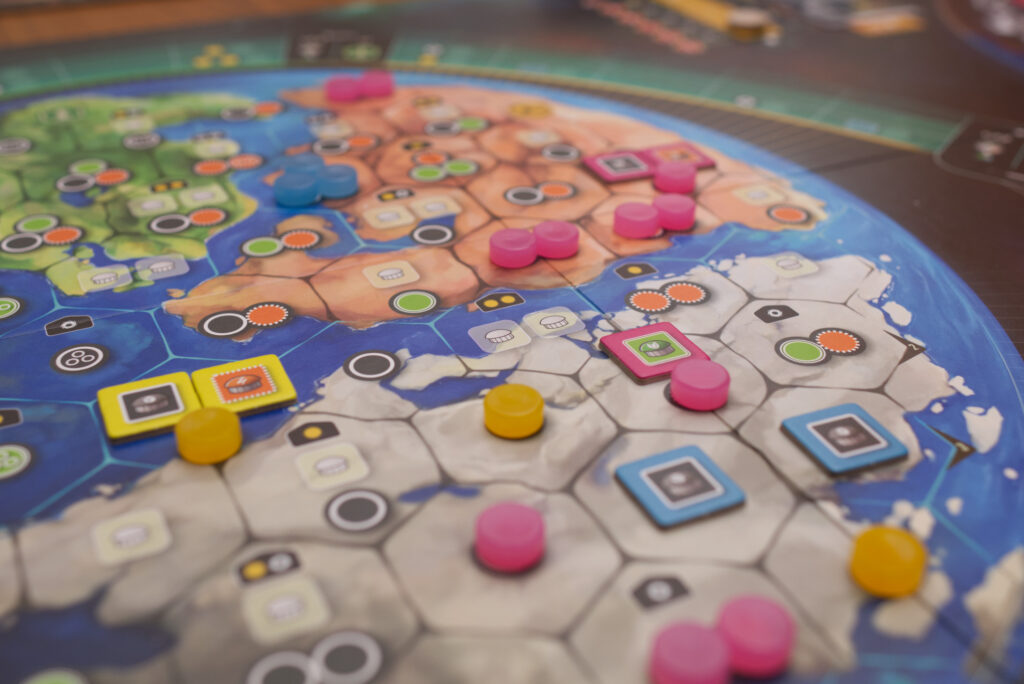
On a completely different level, I was surprised how quick and snappy this game plays. A 3p game in under two hours is no problem at all and afterwards it will feel like having played 20 min. A big portion of this is a result of the game only being 4 rounds long and each individual action being so simple. While it took me a bit to grog the rules and even longer to notice all the small rules mistakes we made in the first 5-6 plays (something I’m unfortunately familiar with from Delicious Games’ style of writing rules), we’re already at a point where the game has a nice flow and strategies emerge. It has become a sandbox we’re now playing in, trying to push the boundaries. When pre-Essen reporting suggested this is Vladimir Suchy’s heaviest game ever, I had somehow expected a 3+ hour monster. Instead, it is complexity-wise more like a Brass: there are actually not that many rules and while some of the details are a bit fiddly, the complexity of Evacuation lies in the interactions of the various mechanisms, not the rules themselves. Teaching it to others for examples feels very natural and easy to me at this point.
However, the thing that keeps me thinking about Evacuation the most is the emotional arc of playing it. In a typical Euro, a player starts off with a small amount of resources and/or opportunities and ends the game with this fully developed economy, engine, or empire which creates a sense of accomplishment. Evacuation though keeps players in a constant state of scarcity and mild frustration: How should I do X with only these few actions? Why is my production not larger? Why can’t I get both the progress bonus and also do the actions I want? Why, oh why, did I pick a food instead of an energy the last time I got a free resource? …
Even when things go well, there is a nagging feeling of underachieving. The only benchmark to know you’re doing okay is hitting that red line marking a production of 8 or more. But even reaching that milestone feels like only having been capable of reaching the bare minimum. At first I thought this might be because there is still so much room for improvement for me. However, when I achieved 82 VP in a solo game (hitting the “mastery” benchmark) I ran out of markers for the population and had to take some off the tech tiles and replace them with cubes. So I must have done something right. Still, it felt like I hadn’t done enough and the game left me slightly unsatisfied.
The end result of all of this is a strange mix: on the one hand, Evacuation is surprisingly easy to teach, quick to play, has a great theme, and clever interlocking mechanisms. One the other hand, it can be somewhat multiplayer solitaire (because you have enough on your hands with your own problems) and a constant struggle. There is no big hurray at the end, just the acknowledgement that you did less poorly than your co-players. Maybe that’s the reason why the rules kick you off with race mode. That way at least, there is a finish line to cross.
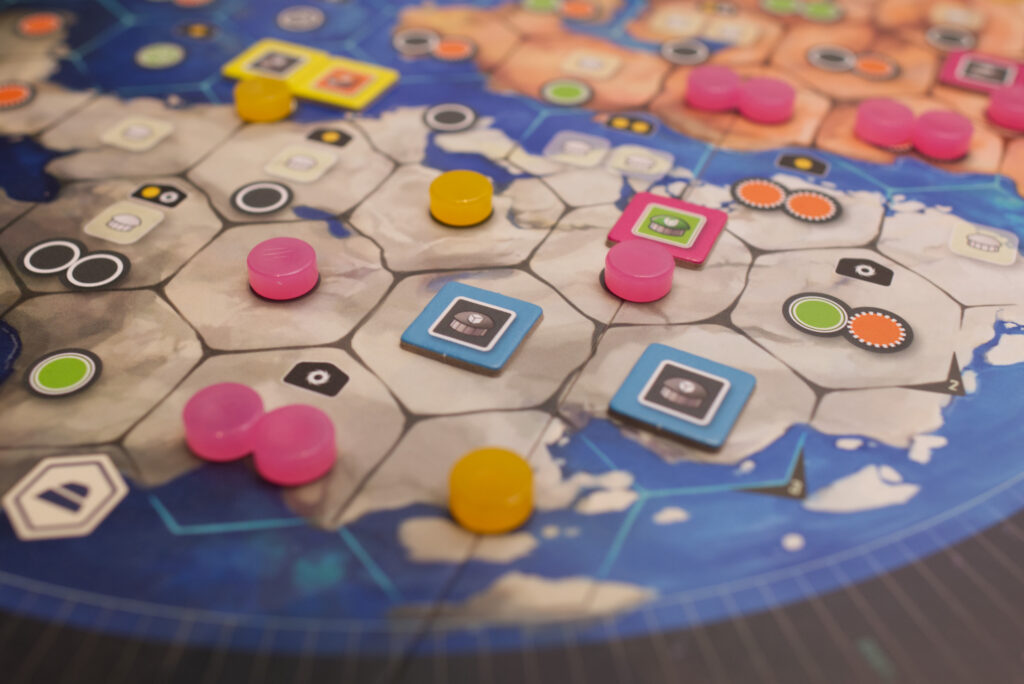
Then there are a multitude of small printing errors like missing numbers or symbols (both on tech tiles and the board), luckily none of which really hinder the playing experience. There are odd graphical design choices (the smiley looks like cheap clipart, factories look like mushrooms, the cardboard tokens placed on the old world look really bland), which forms a stark contrast to the lovely art of the main board and especially the ships. Some iconography we would expect from other games is missing from the main board, like a reminder that markets can be cycled by spending a resource or which lane of the progress track is only used with 3+ players (another point where the rules are ambiguous). For some of the cards like the round bonuses or infrastructure, there is way less variety than one might be used to from other games. I was particularly surprised that there are only two options for the fourth round bonus card. Does the game need more? Probably not, but it feels strange.
There are many potential reasons to dislike Evacuation. I expect a substantial portion of players will not enjoy Evacuation due to the constant struggle without a resounding emotional release or reward at the end. This game is a super tight, punishing puzzle, same as Woodcraft was. The big advantage Evacuation has over Woodcraft is that there is more meat on the bone, more game to be had. As much as I enjoyed Woodcraft, at some point I got the feeling I was done with it and had seen it all. Evacuation on the other hand has staying power. Every time I bring it to the table, I have to adjust to new drafted goals and new combinations of how my tech tiles are arranged. Someone will get in my way on the progress track or even worse settle that one hex I needed to play an infrastructure, screwing my whole round with a single action. I see big potential for the meta game once people are comfortable with the core mechanisms and have time to think about aggressive counter-moves to actively block an opponent as well.
For me, Evacuation is definitely staying in my collection and even has pushed Underwater Cities off the throne as my favourite Suchy design. Evacuation feels faster and easier to play while the challenge is harder and more tangible, plus I like the theme/setting. With UC, I always end up wondering at the end of the game what I did wrong where the answer is painfully obvious in Evacuation! I would play it any time someone suggests it and everyone I’ve played it with so far has liked it as well. However, after now having done many plays in quick succession to write these first impressions, it will probably not be me to suggest it any time soon. When it comes to choosing which game to bring to the table and spend two hours on, there are others that don’t cause so much in-game frustration and provide me with a more gratifying sense of accomplishment … or are just plain more “fun”. In that sense, Evacuation feels akin to great games like Brass or Barrage: I enjoy playing them once in a while when I want a challenge, a tough nut to crack. But I can understand friends that incredulously ask “and you’re playing THAT for fun?”. Still, Evacuation is among the most interesting new games I’ve played this year.
